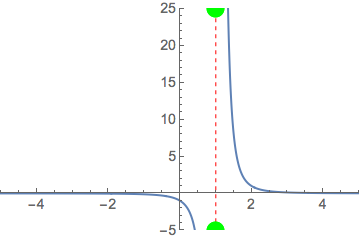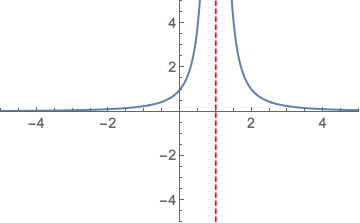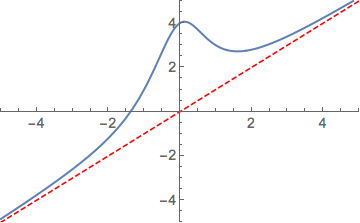There is a good demonstration of how ExclusionStyleExclusionsStyle works here. Check
Plot[Floor[x], {x, 0, 5}, ExclusionsStyle -> {Red, Blue}]
If you use the second form of ExclusionsStyle, you will see the points (boundary of exclusion region) that are being connected withby your asymptote:
Plot[1/(x - 1)^3, {x, -5, 5}, PlotRange -> {{-5, 5}, {-5, 25}}, PlotStyle -> {Thick}, BaseStyle -> {FontSize -> 14}, Exclusions -> {x - 1 == 0}, ExclusionsStyle -> {Directive[Red, Dashed], Directive[PointSize -> 0.05, Green]}] When you have even powerpowers, those two points degenerate into one point and your line becomes invisible.
A possible workaround would be drawing the line separately with Epilog or ListPlot
Plot[1/(x - 1)^2, {x, -5, 5}, PlotRange -> {{-5, 5}, {-5, 5}}, PlotStyle -> {Thick}, BaseStyle -> {FontSize -> 14}, Epilog -> {Directive[Red, Dashed], Line[{{1, -1000}, {1, 1000}}]}] Or
Show[Plot[1/(x - 1)^2, {x, -5, 5}, PlotRange -> {{-5, 5}, {-5, 5}}, PlotStyle -> {Thick}, BaseStyle -> {FontSize -> 14}], ListPlot[{{1, -1000}, {1, 1000}}, Joined -> True, PlotStyle -> Directive[Red, Dashed]]] Or per Kuba's comment:
Plot[1/(x - 1)^2, {x, -5, 5}, PlotRange -> {{-5, 5}, {-5, 5}}, PlotStyle -> {Thick}, BaseStyle -> {FontSize -> 14}, GridLines -> {{1}, None}, GridLinesStyle -> Directive[Red, Dashed]] In the most general case, when your asymptote isn't horizontal or vertical, you will need to plot it as a separate plot. So Exclusions is not the best option:
Plot[{4/(x^2 + 1) + x, x}, {x, -5, 5}, PlotRange -> {{-5, 5}, {-5, 5}}, PlotStyle -> {Thick, Directive[Red, Dashed]}, BaseStyle -> {FontSize -> 14}] 



